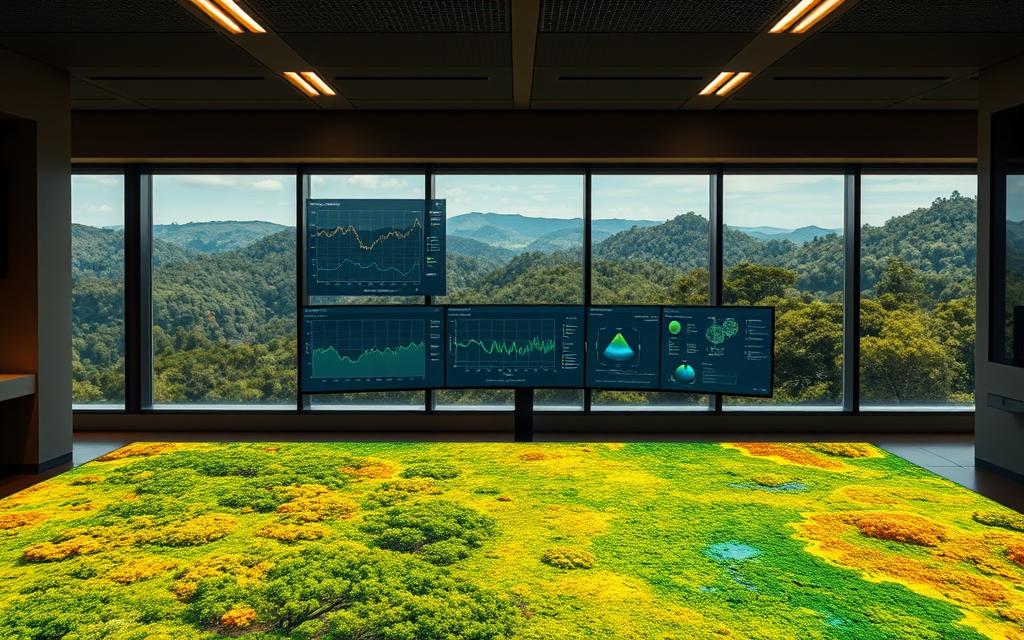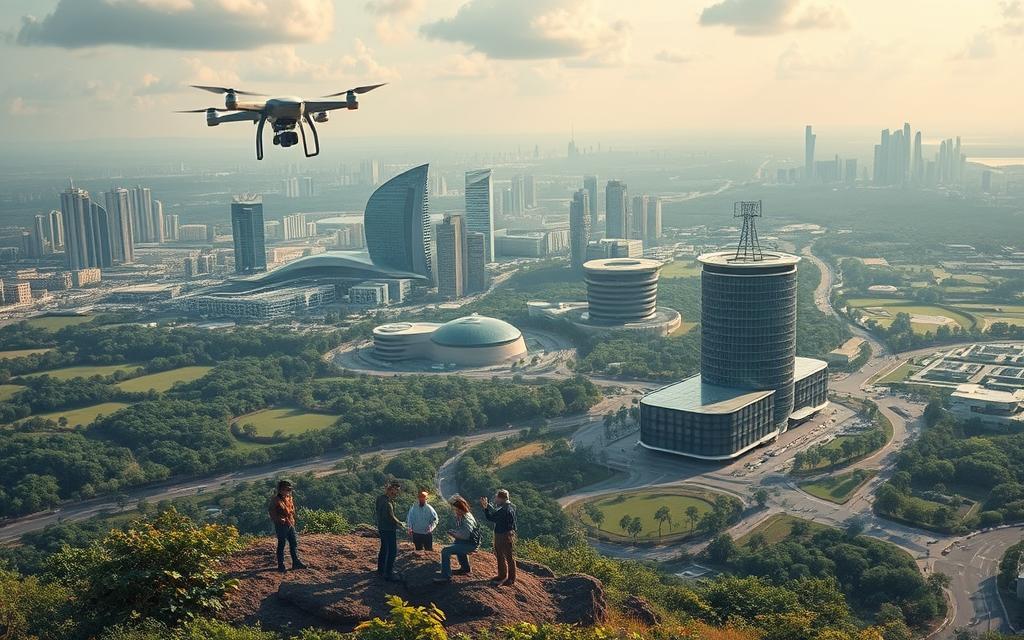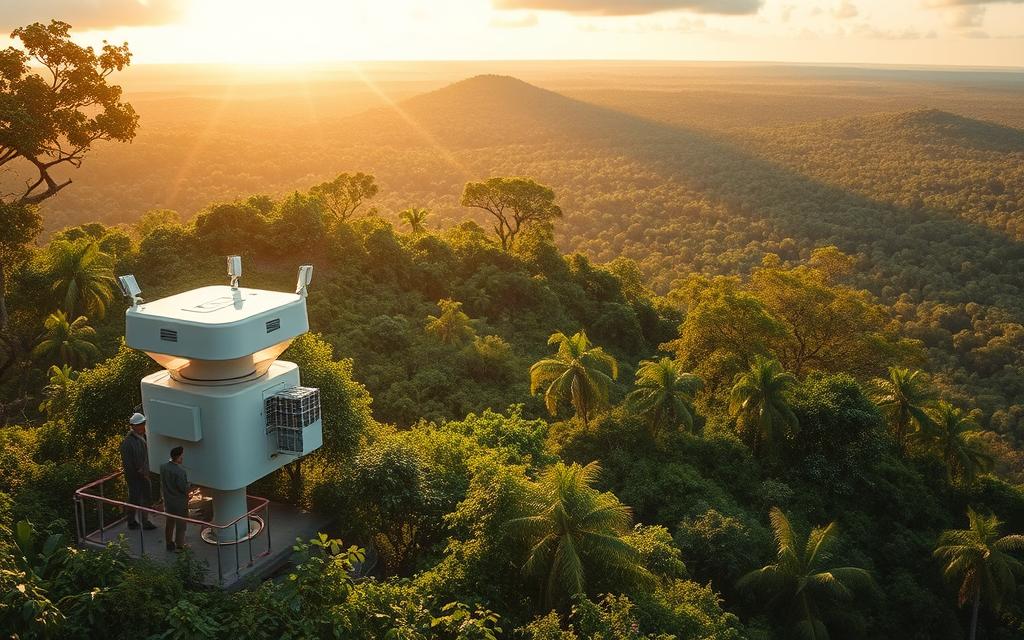Today, we face a big challenge in how we treat the natural world. Technology helps us grow economically, but it also harms our environment. This is one of the biggest conservation threats we have today.
But there’s hope. New environmental technology can help us protect nature. As expert John O’Brien says, we need to use these tools to stop biodiversity loss.
Our progress and preservation efforts are linked in complex ways. New methods like data analysis and habitat monitoring are changing how we save nature. These include technologies for saving biodiversity in the that could change our future.
This article will look at both sides of technology’s impact. We need to understand this balance to find ways that help both people and the planet.
The Role of Technology in Modern Conservation Efforts
Today, conservation uses advanced tech to tackle big environmental issues. These tools help scientists watch over ecosystems, track animal numbers, and spot changes with great accuracy.
Modern conservation technology has changed how we study nature. It moves from old ways to new, data-based methods. These tools let researchers collect info over wide areas without harming nature.
Remote Sensing and Satellite Monitoring
Remote sensing has changed how we see ecosystems from above. With satellite monitoring, scientists can track deforestation, glacier changes, and plant health across the globe.
John O’Brien’s work shows how hyperspectral imagery can check on habitats. It spots stressed plants before they show signs of trouble. Drones add to this by giving detailed views of local areas.
These systems alert us to ecosystem problems fast. This helps groups fighting threats like logging or fires to act quickly.
Acoustic Monitoring and Bioacoustics Technology
Bioacoustics lets us study wildlife by listening. It’s great for finding hard-to-spot animals like sea mammals and night creatures.
Autonomous units record sounds in remote places for a long time. Then, special software looks at these recordings to find out what animals are there and how many. It can even tell us how they behave.
This tech also spots when people enter protected areas illegally. It does this by listening for sounds of poaching or vehicles. It’s quiet and doesn’t disturb animals, giving us useful data over time.
Environmental DNA (eDNA) Sampling
eDNA sampling is a new way to study nature. It looks at genetic material left behind by animals in their environment.
By testing water, soil, or air, researchers can find out what species are around. It’s good for catching invasive species early. New tech makes it easier and faster to do this in the field.
This method is kind to animals and gives us good info on where they are. It’s changed how we check on biodiversity in delicate places.
| Technology Type | Primary Applications | Data Collection Method | Conservation Benefits |
|---|---|---|---|
| Remote Sensing | Habitat mapping, deforestation monitoring | Satellite imagery, drone photography | Large-scale ecosystem assessment |
| Bioacoustics | Species detection, behavioural studies | Audio recording devices | Non-invasive wildlife monitoring |
| eDNA Sampling | Species presence detection, biodiversity surveys | Environmental sample collection | Early invasive species detection |
These technologies are very helpful but we must think about their impact. We need to use them wisely, respecting nature and local people.
Using these tools is a big step forward in protecting our planet. As they get better, they will help us even more in our mission to save nature.
How Does Technology Affect Biodiversity Through Data Analysis
Advanced data analysis technologies are changing how we protect biodiversity. They turn raw data into useful insights. This helps conservationists make better choices.

Artificial Intelligence in Species Identification
Machine learning can now identify species from images and sounds. Camera traps and drones collect millions of observations. But, manual analysis would take years.
AI can process these images in hours, identifying animals with great accuracy. This AI species identification tracks population changes and finds rare species.
Researchers at top universities have made systems to identify birds by song and mammals by pattern. This technology greatly improves monitoring in large areas.
Predictive Modelling for Conservation Planning
Conservationists use computer models to predict environmental changes and plan actions. These models look at climate patterns, habitat data, and species movements.
Climate researcher O’Brien says predictive modelling helps predict droughts, fires, and other threats. It allows for early actions like creating wildlife corridors or changing water management.
These models test different scenarios, showing how ecosystems might react to conservation strategies. This helps focus on the most effective actions with limited resources.
Big Data Analytics for Ecosystem Management
Modern conservation works with huge datasets from satellites, sensors, and field observations. Big data analytics finds patterns humans might overlook.
These systems track deforestation rates, monitor water quality, and check habitat health across continents. The insights guide ecosystem management decisions at all levels.
But, critics like Stinson warn against corporate greenwashing. Some companies use big data analytics to look green while supporting harmful industries.
“We cannot celebrate data-driven conservation while ignoring the contradictions in corporate environmental practices.”
Ethical use of biodiversity data is key. Technology helps conservation most when used with honest practices and real commitment.
Technological Threats to Biodiversity
Technology brings us amazing tools for saving nature, but it also poses big environmental risks. The innovations meant to help nature can actually harm it in many ways.
Habitat Fragmentation from Infrastructure Development
New construction tech lets us build and extract resources fast, often harming nature. These projects split wildlife habitats, making it hard for animals to move and find food.
O’Brien’s study shows how protected areas are being eaten away by nearby development. The Great Barrier Reef, for example, is suffering from coastal projects made possible by modern engineering.
Fragmentation leads to:
- Less genetic diversity in isolated animals
- Broken migration and feeding paths
- Changes in local climates near habitat edges
- More chance of invasive species
Pollution from Electronic Waste and Resource Extraction
The tech world creates a lot of pollution through its making and waste. Devices filled with harmful materials can pollute the environment if not thrown away right.
Stinson’s study points out the harm from mining for tech parts:
- Contamination of soil and water with heavy metals
- Air pollution from processing plants
- Depletion of resources in delicate ecosystems
E-waste is a big problem as more devices are used and thrown away. Poor recycling in some countries makes things worse.
Increased Human Access and Disturbance Through Technology
New transport and monitoring tech let us visit nature spots more often. This brings more pressure on wildlife and their homes.
O’Brien’s work shows how tech access leads to:
- More conflicts between humans and animals
- More poaching with better tools and tracking
- Disturbance of animals during important times
- Faster spread of diseases and invasive species
Recreational tech like drones and ATVs also adds to the problem. They often go where animals have little protection from humans.
We need to manage these tech threats with good policies and corporate actions. Finding a balance between tech progress and nature protection is key for a sustainable future.
Emerging Technologies and Future Conservation Prospects
The world of conservation is changing fast with new technologies. These tools offer great chances to save our planet’s wildlife. But, they also bring new challenges that need careful thought.

Gene Editing and Conservation Genetics
Genetic tech is changing how we save species. Conservation genetics now uses gene editing and freezing genetic material.
The cloning of the bucardo mountain goat shows we can bring back extinct species. Assisted reproductive technologies (ART) give hope to endangered animals with few left.
But, there are big problems:
- It costs a lot of money
- There are tough ethical questions
- It’s hard to use these technologies
- It’s not clear if they fit into nature
As one expert says, “Biotechnology gives us tools, not answers. We must think carefully about each use”.
Robotics and Autonomous Conservation Systems
Autonomous systems are changing how we watch over fragile ecosystems. Robotics in conservation uses drones for flying surveys and remote sensing in hard-to-reach places.
These tools help by:
- Watching wildlife in real-time
- Keeping humans out of sensitive areas
- Getting more data
- Responding faster to dangers
The idea of bio-hybrid systems raises both hopes and worries. While they can go where animals can’t, we must think about their impact on animals.
Blockchain for Sustainable Resource Management
Digital ledger tech has great uses for conservation. Blockchain makes wildlife trade and resource use more open.
This tech helps with sustainable management by:
- Making sure harvesting is legal
- Tracking products that are sustainably made
- Stopping illegal trade
- Letting buyers know where their products come from
But, there are big hurdles to overcome. We need to see if it really works in the real world. It must be easy for conservation groups to use, even if they don’t have much money.
These new technologies are exciting for conservation science. But, they can only work if we balance their benefits with the needs of nature.
Conclusion
Technology is a double-edged sword for biodiversity. It gives us tools like remote sensing and AI to watch over species. But it also brings dangers like habitat loss and pollution.
Kathleen O’Brien says we must adopt technology fast. Edward Conway sees it as a costly but needed fix for nature’s future.
Using technology ethically is key. Melissa Stinson and Sean Mcloughlin suggest letting Indigenous people lead. This way, we respect their knowledge and avoid greenwashing.
Getting communities involved is also important. It makes sure technology helps both people and nature.
This summary shows the mixed role of technology in saving biodiversity. New tools can help, but only if we use them wisely. The future needs both modern science and ancient wisdom for a green world.







